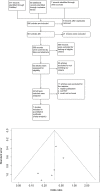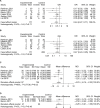Impact of preoperative exercise therapy on surgical outcomes in lung cancer patients with or without COPD: a systematic review and meta-analysis
- PMID: 30858729
- PMCID: PMC6387612
- DOI: 10.2147/CMAR.S186432
Impact of preoperative exercise therapy on surgical outcomes in lung cancer patients with or without COPD: a systematic review and meta-analysis
Abstract
Objectives: This meta-analysis aimed to demonstrate the impact of preoperative exercise therapy on surgical outcomes in patients with lung cancer and COPD. Pulmonary function and muscle capacity were investigated to explore their potential links with outcome improvements after exercise.
Methods: Articles were searched from PubMed, Embase, and the Cochrane Library with criteria of lung cancer patients with or without COPD, undergoing resection, and receiving preoperative exercise training. Key outcomes were analyzed using meta-analysis.
Results: Seven studies containing 404 participants were included. Patients receiving preoperative exercise training had a lower incidence of postoperative pulmonary complications (PPCs; OR 0.44, 95% CI 0.27-0.71) and shorter length of hospital stay (standardized mean difference -4.23 days, 95% CI -6.14 to -2.32 days). Exceptionally, pneumonia incidence remained unchanged. Patients with COPD could not obviously benefit from exercise training to reduce PPCs (OR 0.44, 95% CI 0.18-1.08), but still might achieve faster recovery. No significant difference in pulmonary function was observed between the two groups. However, 6MWD and VO2 peak were significantly improved after exercise training.
Conclusion: Preoperative exercise training may reduce PPCs for lung cancer patients. However, for patients with COPD undergoing lung cancer resection, the role of exercise is uncertain, due to limited data, which calls for more prospective trials on this topic. Rehabilitation exercise strengthens muscle capacity, but does not improve impaired pulmonary function, which emphasizes the possible mechanism of the protocol design.
Keywords: 6MWD; COPD; VO2 peak; lung cancer; postoperative pulmonary complications; preoperative exercise.
Conflict of interest statement
Disclosure The authors report no conflicts of interest in this work.
Figures





Similar articles
-
Preoperative Exercise Training to Prevent Postoperative Pulmonary Complications in Adults Undergoing Major Surgery. A Systematic Review and Meta-analysis with Trial Sequential Analysis.Ann Am Thorac Soc. 2021 Apr;18(4):678-688. doi: 10.1513/AnnalsATS.202002-183OC. Ann Am Thorac Soc. 2021. PMID: 33030962
-
Exercise training undertaken by people within 12 months of lung resection for non-small cell lung cancer.Cochrane Database Syst Rev. 2019 Jun 17;6(6):CD009955. doi: 10.1002/14651858.CD009955.pub3. Cochrane Database Syst Rev. 2019. PMID: 31204439 Free PMC article.
-
Impact of breathing exercises in subjects with lung cancer undergoing surgical resection: A systematic review and meta-analysis.J Clin Nurs. 2019 Mar;28(5-6):717-732. doi: 10.1111/jocn.14696. Epub 2018 Nov 20. J Clin Nurs. 2019. PMID: 30357997
-
Does preoperative pulmonary rehabilitation/physiotherapy improve patient outcomes following lung resection?Interact Cardiovasc Thorac Surg. 2021 May 27;32(6):933-937. doi: 10.1093/icvts/ivab011. Interact Cardiovasc Thorac Surg. 2021. PMID: 33907813 Free PMC article.
-
Prehabilitation Interventions for Cardiac Surgery to Prevent Postoperative Pulmonary Complications: Systematic Review and Meta-Analysis.Iran J Public Health. 2024 Oct;53(10):2167-2179. doi: 10.18502/ijph.v53i10.16683. Iran J Public Health. 2024. PMID: 39544863 Free PMC article. Review.
Cited by
-
Mechanisms of exercise in the treatment of lung cancer - a mini-review.Front Immunol. 2023 Aug 24;14:1244764. doi: 10.3389/fimmu.2023.1244764. eCollection 2023. Front Immunol. 2023. PMID: 37691942 Free PMC article. Review.
-
Resectability versus Operability in Early-Stage Non-Small Cell Lung Cancer.Curr Oncol Rep. 2024 Jan;26(1):55-64. doi: 10.1007/s11912-023-01477-3. Epub 2023 Dec 22. Curr Oncol Rep. 2024. PMID: 38133722 Review.
-
Factors Influencing Functional Exercise Capacity After Lung Resection for Non-Small Cell Lung Cancer.Integr Cancer Ther. 2020 Jan-Dec;19:1534735420923389. doi: 10.1177/1534735420923389. Integr Cancer Ther. 2020. PMID: 32493079 Free PMC article.
-
Preoperative respiratory muscle training combined with aerobic exercise improves respiratory vital capacity and daily life activity following surgical treatment for myasthenia gravis.J Cardiothorac Surg. 2023 Apr 24;18(1):160. doi: 10.1186/s13019-023-02283-5. J Cardiothorac Surg. 2023. PMID: 37095505 Free PMC article. Clinical Trial.
-
The Physical Activity and Cancer Control (PACC) framework: update on the evidence, guidelines, and future research priorities.Br J Cancer. 2024 Oct;131(6):957-969. doi: 10.1038/s41416-024-02748-x. Epub 2024 Jun 27. Br J Cancer. 2024. PMID: 38926526 Free PMC article. Review.
References
-
- Edvardsen E, Skjonsberg OH, Holme I, et al. High-intensity training following lung cancer surgery: a randomised controlled trial. Thorax. 2015;70:244–250. - PubMed
-
- Maeda K, Higashimoto Y, Honda N, et al. Effect of a postoperative outpatient pulmonary rehabilitation program on physical activity in patients who underwent pulmonary resection for lung cancer. Geriatr Gerontol Int. 2016;16:550–555. - PubMed
-
- Esteban PA, Hernandez N, Novoa NM, et al. Evaluating patients’ walking capacity during hospitalization for lung cancer resection. Interactive cardiovascular and thoracic surgery. 2017;25:268–271. - PubMed
Publication types
LinkOut - more resources
Full Text Sources

